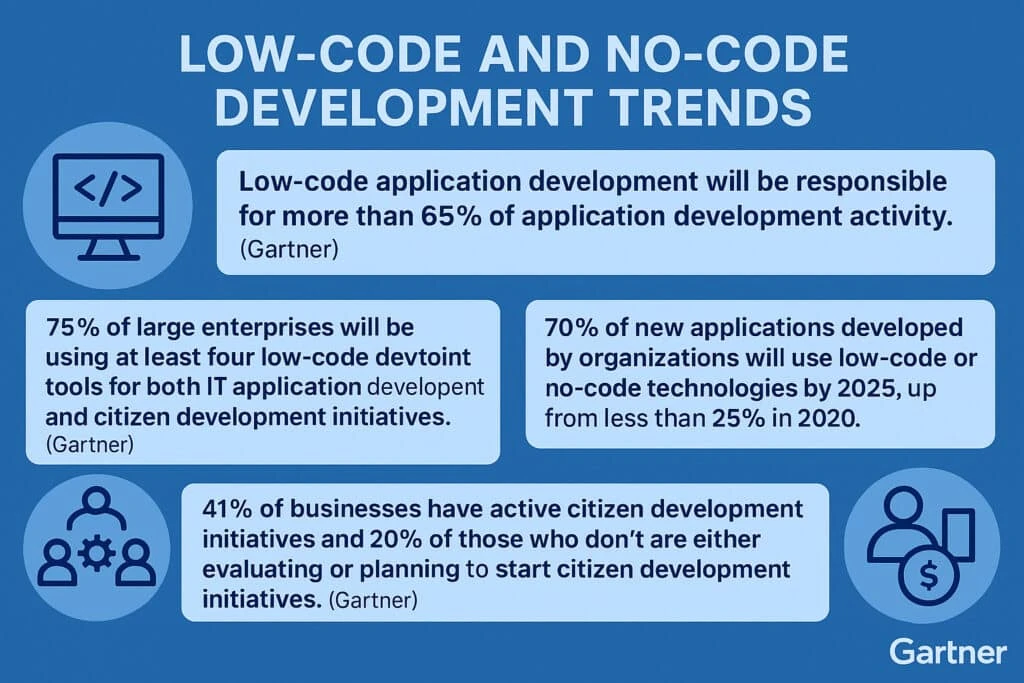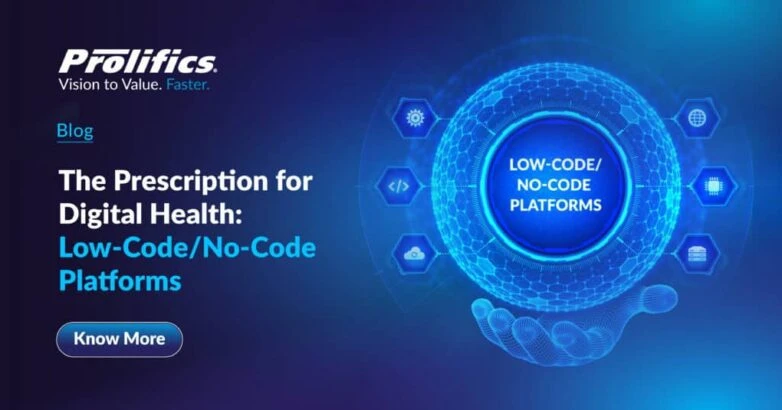The healthcare industry is undergoing a seismic transformation driven by digital innovation, regulatory shifts, and rising patient expectations. However, legacy systems, complex integrations, and prolonged development cycles often hinder timely innovation.
Low-code no-code platforms in healthcare are emerging as a powerful antidote, enabling rapid application development in healthcare with minimal coding, empowering non-technical users, and accelerating digital health low-code solutions across the care continuum.
According to Gartner, 70% of new applications developed by organizations will use low-code or no-code technologies by 2025, and healthcare is leading the charge.
For providers, payers, and healthcare innovators, LCNC platforms are now a strategic lever to deliver high-quality care, enhance patient experiences, and maintain compliance—all with greater speed and agility.

What Are Low-Code No-Code Platforms in Healthcare?
Low-code and no-code platforms simplify healthcare application development platforms through visual, drag-and-drop interfaces, minimizing the need for traditional programming.
- Low-code platforms reduce manual coding with reusable components.
- No-code platforms allow non-technical users to build complete apps using pre-built modules and workflows.
These tools lower costs, reduce complexity, and accelerate software delivery — helping clinicians, administrators, and analysts co-create digital solutions tailored to patient needs.
Why Healthcare Needs Low-Code/No-Code
1. Accelerating Innovation in Patient Care
Traditional IT cycles often lag behind the urgency of healthcare innovation. LCNC platforms for healthcare innovation allow rapid prototyping, testing, and deployment for telehealth, remote monitoring, and personalized medicine.
Healthcare organizations can launch COVID-19 vaccination portals, mental health apps, and other patient tools without long development delays.
2. Empowering Frontline Healthcare Workers
Doctors, nurses, and administrators understand pain points better than most IT teams.
With no-code tools, they can build and customize:
- Scheduling workflows
- Patient intake forms
- Resource management dashboards
This user-centric development model boosts efficiency, reduces IT dependency, and shortens feedback loops.
3. Seamless Integration with Legacy Systems
Many healthcare organizations still rely on outdated EHRs and billing systems.
Using LCNC, they can modernize legacy systems through APIs, middleware, and prebuilt connectors — without disrupting daily operations.
Prolifics specializes in integrating and modernizing these systems securely.
4. Faster Compliance and Regulatory Response
Regulations like HIPAA, HITECH, and GDPR require strict data governance.
LCNC platforms can:
- Automate compliance workflows
- Log access events
- Generate real-time audit reports
This helps healthcare providers stay compliant while focusing on patient care.
Key Healthcare Use Cases for Low-Code/No-Code Platforms
1. Frictionless Patient Onboarding & Personalized Engagement
LCNC tools enable quick creation of:
- Patient onboarding forms
- Appointment scheduling apps
- Secure messaging systems
They can integrate with EHRs and CRM tools to deliver personalized follow-ups and care instructions without developer intervention.
2. Enabling Always-On Remote Care Through Wearables & Telehealth
By combining LCNC with IoT and wearable integrations, healthcare organizations can build real-time dashboards that track patient vitals and trigger alerts for anomalies.
No-code interfaces can power telehealth workflows, intake, consent, and video consultations, without developing from scratch.
3. Claims Management and Revenue Cycle Automation
Insurance claims processing can be slow and error-prone. LCNC platforms can digitize claims intake, automate eligibility verification, track claim statuses, and escalate exceptions, all with minimal IT involvement. This reduces denials, speeds reimbursements, and improves payer-provider relationships.
4. Clinical Workflow Automation
From lab result routing to discharge planning, LCNC platforms simplify complex workflows across departments. Drag-and-drop automation tools allow healthcare staff to optimize task sequences, reduce paperwork, and improve coordination among clinicians.
5. Data Collection and Reporting
Hospitals often struggle to collect structured data.
LCNC platforms can:
- Build data collection forms
- Sync data to dashboards and data lakes
- Track KPIs for infection control, outcomes, and performance
No coding expertise required — empowering teams to make data-driven decisions..
Benefits of LCNC in Healthcare
1. Rapid Time-to-Market
Solutions can be built and deployed within days or weeks rather than months, vital for responding to public health emergencies, policy changes, or competitive threats.
2. Cost-Efficiency
By reducing the need for large development teams and minimizing maintenance overhead, LCNC platforms significantly lower the total cost of ownership for healthcare IT solutions.
3. Improved User Adoption
Apps built with input from clinical and administrative staff often see higher adoption and satisfaction rates. LCNC platforms foster this collaboration by making development accessible.
4. Scalability and Flexibility
Modern LCNC platforms like Mendix, OutSystems, and Appian can handle enterprise-grade deployments, support cloud-native architectures, and scale on demand, all essential for healthcare environments.
5. Built-in Security and Governance Most LCNC vendors offer enterprise-level security features, including encryption, role-based access control, audit trails, and secure API gateways, essential for safeguarding patient data.
Overcoming Challenges
LCNC platforms aren’t without risks — such as governance issues or platform sprawl.
To mitigate these, organizations should:
Partner with experienced firms like Prolifics for implementation and optimization
Establish a Center of Excellence (CoE)
Use enterprise-grade LCNC platforms with strong integration capabilities
Involve IT leaders for architecture and compliance oversight
Key mitigation strategies include:
- Establishing a Center of Excellence (CoE) to manage best practices and governance
- Using enterprise-grade platforms with strong integration and security capabilities
- Involving IT leaders to guide architecture and compliance oversight
- Partnering with experienced providers like Prolifics to tailor LCNC implementation for the healthcare environment
Prolifics’ Role in Healthcare LCNC Innovation
At Prolifics, we combine domain expertise in healthcare with cutting-edge capabilities in low-code/no-code, AI, and analytics to drive measurable outcomes. We help clients:
- Modernize legacy healthcare systems using LCNC integration frameworks
- Build patient-facing apps that elevate care and satisfaction
- Automate backend processes like claims, compliance, and credentialing
- Enable real-time analytics with LCNC-built dashboards
- Create secure, HIPAA-compliant digital solutions at speed
Whether you’re a provider looking to improve care coordination or a payer seeking operational efficiency, Prolifics can help you unlock the full potential of low-code/no-code platforms.
Future Outlook: LCNC as the New Standard in Healthcare Innovation
Low-code and no-code platforms are no longer niche tools, they are becoming foundational to the future of digital healthcare. As AI and ML become integrated into these platforms, their ability to support intelligent automation and predictive care will grow exponentially.
From precision medicine to value-based care, LCNC platforms will enable faster experimentation, improved agility, and broader participation in digital transformation. Healthcare organizations that embrace this shift now will be better positioned to lead in an increasingly competitive and data-driven landscape.
Conclusion
The healthcare sector faces constant pressure to innovate and improve outcomes. Low-code no-code platforms in healthcare empower both technical and non-technical teams to create solutions faster, integrate securely, and scale with confidence.
Prolifics is ready to guide your low-code no-code healthcare transformation so you can lead in a competitive, data-driven world—one drag-and-drop solution at a time.




